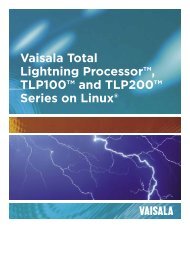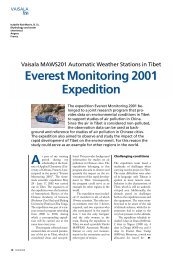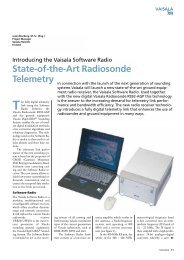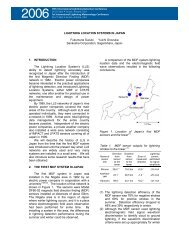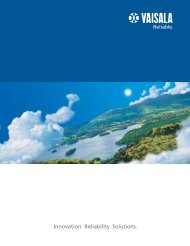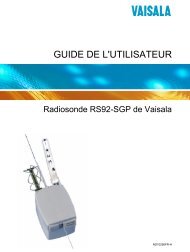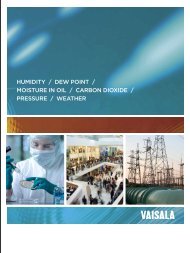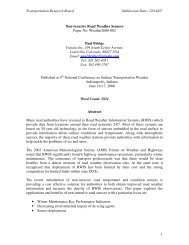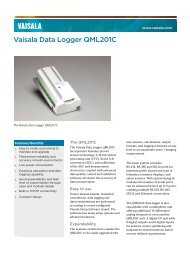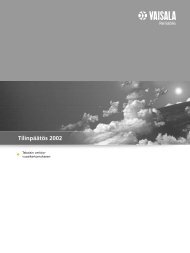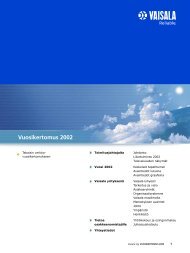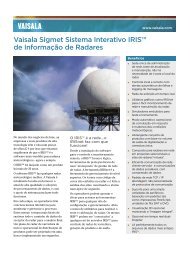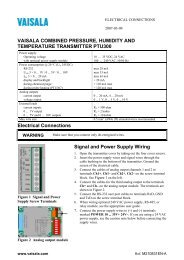Vaisala Humidity 101 - Humidity Sensor Technology Tutorial
Vaisala Humidity 101 - Humidity Sensor Technology Tutorial
Vaisala Humidity 101 - Humidity Sensor Technology Tutorial
You also want an ePaper? Increase the reach of your titles
YUMPU automatically turns print PDFs into web optimized ePapers that Google loves.
Welcome<br />
<strong>Vaisala</strong> <strong>Humidity</strong> <strong>101</strong> – <strong>Humidity</strong> <strong>Sensor</strong> <strong>Technology</strong> - <strong>Tutorial</strong><br />
Bruce McDuffee<br />
<strong>Vaisala</strong> <strong>Humidity</strong><br />
Instructor<br />
Yumi Shakya<br />
<strong>Vaisala</strong> Application<br />
Engineer
<strong>Humidity</strong> <strong>101</strong><br />
\ webinar series<br />
<strong>Humidity</strong> <strong>Sensor</strong> <strong>Technology</strong> - <strong>Tutorial</strong>
Agenda<br />
1. <strong>Sensor</strong> Technologies<br />
• Mechanical/Organic<br />
• Psychrometers<br />
• Chilled mirror<br />
• Electronic<br />
2. <strong>Vaisala</strong> HUMICAP ® Training<br />
• Heated probe<br />
• Chemical purge<br />
3. <strong>Vaisala</strong> DRYCAP ® Training<br />
Page 3 / 11/10/08 / BEMD / ©<strong>Vaisala</strong>
Mechanical<br />
Exploit the expansion and contraction of organic materials with changes<br />
in humidity; changes are amplified through the use of levers that move a<br />
needle or pointer.<br />
• horse hair, human hair, catgut, goldbeater’s skin, textile, or plastic<br />
hair element<br />
Page 4 / 11/10/08 / BEMD / ©<strong>Vaisala</strong>
Mechanical<br />
+ cheap to buy<br />
+ no power needed<br />
- 20…90% best range<br />
- Uncertainty from +/-5% up to +/-15%<br />
- calibrated with a wet rag to 100%;<br />
no dry end calibration<br />
- considerable hysteresis<br />
- responds to changes in humidity<br />
very slowly<br />
hair element<br />
Page 5 / 11/10/08 / BEMD / ©<strong>Vaisala</strong>
Psychrometer (wet-dry bulb)<br />
Two matched thermometers over which air is drawn. One thermometer<br />
has the bulb covered by a wet ‘cloth’ or ‘wick’. This is the ‘wet-bulb’.<br />
dry bulb<br />
wet bulb<br />
cloth<br />
water<br />
Page 6 / 11/10/08 / BEMD / ©<strong>Vaisala</strong>
Psychrometer (wet-dry bulb)<br />
+ simple & fundamental measurement<br />
+ relatively cheap ($35 to $80 for sling)<br />
+ can have good stability<br />
+ tolerates condensation without<br />
damage<br />
ENC LO SURE<br />
7<br />
HYGROMETRIC<br />
TABLES<br />
8<br />
- High uncertainty (+/- 2% to 5%)<br />
- requires some skill to use & maintain<br />
- results usually must be calculated<br />
- requires large air sample<br />
- sample will be humidified (altered) by<br />
water that is evaporating<br />
- accuracy affected by<br />
contaminated/dirty wick<br />
1 2<br />
3<br />
4<br />
HYGROMETER<br />
5<br />
6<br />
1<br />
2<br />
3<br />
4<br />
fa n motor hea t introduc ed<br />
turbulanc e<br />
thick wick<br />
contaminated wick<br />
wick quality<br />
porous (ce ra mic ) slee ve<br />
non-sealed thermometers<br />
no n-id e ntica l the rmo mete rs<br />
poor resolution instrum ents<br />
low accuracy instruments<br />
5<br />
6<br />
7<br />
8<br />
p oor w a te r q ua lity<br />
wa ter tem pe ra ture cha ng es a ffec t d ep re ssion<br />
wa ter container m ate ria l non- plastic<br />
two-wire system causes errors<br />
tables, accuracy of reading<br />
Page 7 / 11/10/08 / BEMD / ©<strong>Vaisala</strong>
Condensation Hygrometer<br />
Chilled Mirror<br />
light<br />
NO DEW<br />
detector<br />
light<br />
DEW<br />
detector<br />
chilled mirror<br />
chilled mirror<br />
Page 8 / 11/10/08 / BEMD / ©<strong>Vaisala</strong>
Condensation Hygrometer<br />
+ precise measurement (+/-.1C)<br />
+ wide measurement range (-100..+100C)<br />
+ very good long term performance<br />
+ fundamental measurement<br />
- expensive<br />
- usually requires some skill/training to operate<br />
- mirror cannot tell ice or dew<br />
- contamination on mirror causes errors<br />
- requires frequent maintenance<br />
- complex in construction<br />
Page 9 / 11/10/08 / BEMD / ©<strong>Vaisala</strong>
Electrical <strong>Sensor</strong>s<br />
Resistive<br />
Capacitive – thin film polymer<br />
Capacitive – aluminum oxide<br />
Page 10 / 11/10/08 / BEMD / ©<strong>Vaisala</strong>
Resistive <strong>Humidity</strong> <strong>Sensor</strong>s<br />
Measures the electrical impedance or resistance of a hygroscopic<br />
medium such as conductive polymer, salt, or a treated substrate.<br />
The resistance changes inversely with<br />
humidity.<br />
Page 11 / 11/10/08 / BEMD / ©<strong>Vaisala</strong>
Resistive <strong>Humidity</strong> <strong>Sensor</strong>s<br />
+ small and cheap<br />
+ mass production possible<br />
+ Interchangeable/field<br />
replaceable<br />
- limited range (typically 15...95 %RH)<br />
- high temperature dependency<br />
- poor stability<br />
- sensitive to contamination, condensation<br />
- reading altered by all substances that<br />
affect resistance; salts, hydrogen,<br />
oxidizing agents, other chemicals<br />
Page 12 / 11/10/08 / BEMD / ©<strong>Vaisala</strong>
Capacitive - Aluminum Oxide (Al 2 O 3 )<br />
• capacitor which consists of aluminum and gold electrodes and an aluminum oxide<br />
insulator<br />
• responds to the partial pressure of water vapor and converted to absolute units (for<br />
Td or ppm)<br />
Page 13 / 11/10/08 / BEMD / ©<strong>Vaisala</strong>
Capacitive - Aluminum Oxide (Al 2 O 3 )<br />
+ small<br />
+ suitable for in-line site use<br />
+ wide measuring range<br />
measures dewpoint down<br />
to -75...-100 °C<br />
- condensation or<br />
contamination on sensor<br />
causes significant<br />
calibration shift<br />
- slow response time<br />
- long stabilization time<br />
- need frequent calibration<br />
- significant drift<br />
- considerable hysteresis<br />
Page 14 / 11/10/08 / BEMD / ©<strong>Vaisala</strong>
Capacitive – thin film polymer<br />
upper electrode<br />
lower<br />
electrode<br />
thin-film polymer<br />
glass substrate<br />
• measures the capacitance of an electrode where a polymer acts as<br />
the dielectric portion of the capacitor<br />
• the properties of the polymer/dielectric change proportionately with<br />
the change in relative humidity which results in a change of the<br />
measured capacitance<br />
Page 15 / 11/10/08 / BEMD / ©<strong>Vaisala</strong>
Capacitive – thin film polymer<br />
+ wide measurement range 0...100<br />
%RH<br />
+ wide temperature range (up to 200C)<br />
+ excellent stability<br />
+ fast response<br />
+ full recovery from condensation<br />
+ highly resistant to contaminants<br />
+ small<br />
+ low cost<br />
+ require very little maintenance<br />
- can be limited by distance from<br />
electronics to sensor<br />
- loss of relative accuracy at low<br />
end (
Other technologies<br />
• Saturated Lithium Chloride<br />
• uses hygroscopic salt as a sensing medium, with voltage applied across the salt and measures<br />
current; usually displays dewpoint<br />
• Spectroscopic<br />
• measures the light at a specific bandwidth where water vapor absorbs the light, based on the<br />
principle of infrared absorbance.<br />
• Color change<br />
• material such as cobalt chloride will change color based on the amount of water vapor in the air<br />
as it reacts with the chemical<br />
• Acoustic<br />
• transmission of sound in air can indicate humidity<br />
• Adiabatic Expansion<br />
• cooling of air on expansion produces a cloud or fog if the dewpoint temperature is reached<br />
Page 17 / 11/10/08 / BEMD / ©<strong>Vaisala</strong>
For example, the <strong>Vaisala</strong> HUMICAP ®<br />
thin film polymer capacitive sensor<br />
upper electrode<br />
lower<br />
electrode<br />
thin-film polymer<br />
glass substrate<br />
Page 18 / 11/10/08 / BEMD / ©<strong>Vaisala</strong>
<strong>Vaisala</strong> HUMICAP ® Basic Specifications<br />
• Accuracy - +/- 1% .... +/-3%<br />
• Relative <strong>Humidity</strong> Range: 0 ... 100%<br />
• Temperature Range: -94F ... +356F<br />
• Pressure Range: 0...100bar<br />
• Response time(90%): 8s ... 40s<br />
Page 19 / 11/10/08 / BEMD / ©<strong>Vaisala</strong>
<strong>Vaisala</strong> HUMICAP ® - Maintenance<br />
Calibration Interval<br />
HUMICAP 180R ®<br />
Page 20 / 11/10/08 / BEMD / ©<strong>Vaisala</strong>
FAQ on use of <strong>Vaisala</strong> HUMICAP ®<br />
1. Is performance affected if water gets on the sensor?<br />
2. Will certain chemicals affect the accuracy?<br />
3. Will dust affect the performance?<br />
4. Can the sensor be cleaned?<br />
5. Can the sensor be replaced?<br />
6. Will it work in gases other than air?<br />
7. What spare parts should I carry?<br />
Page 21 / 11/10/08 / BEMD / ©<strong>Vaisala</strong>
<strong>Vaisala</strong> HUMICAP ®<br />
Not recommended for use in these conditions:<br />
1. Combined high temperature/high<br />
humidity (e.g. +90°C/90 %RH)<br />
2. High concentrations of corrosive<br />
gases and/or solvents<br />
3. Temperature > 180C (356F)**<br />
4. Temperature < -70C (-94F)**<br />
5. Conditions beyond instrument<br />
specifications<br />
** Note: This is the extreme case, some instruments specifications are more stringent<br />
Page 22 / 11/10/08 / BEMD / ©<strong>Vaisala</strong>
HUMICAP © Heated Probe <strong>Technology</strong><br />
• Entire probe is warmed 2…3 degrees above ambient temperature<br />
• Prevents condensation from occurring on the sensor even in a 100% RH environment<br />
• Also prevents a ‘true’ RH reading because of the heating<br />
• Output is dewpoint temperature (not affected by temperature)<br />
• Use separate temperature probe for calculating RH if needed<br />
Where is it used?<br />
• concrete curing room<br />
• high humidity testing chambers<br />
• outdoor measurements<br />
HMT337<br />
Page 23 / 11/10/08 / BEMD / ©<strong>Vaisala</strong>
HUMICAP ® 180C – composite sensor<br />
Polymer sensor<br />
PT-100<br />
* Available on all HMT330 series instruments<br />
Page 24 / 11/10/08 / BEMD / ©<strong>Vaisala</strong>
HUMICAP ® 180C - how to use it<br />
• <strong>Sensor</strong> purge (re-gain)<br />
– activated automatically once each 12 hours (if turned on)<br />
– sensor heated up to ~ +180°C<br />
• XHEAT<br />
– Activates at set point; i.e. 95% RH<br />
Ethyl acetate (apr.700ppm) 4-7.10.97<br />
75<br />
Where is it used?<br />
70<br />
65<br />
60<br />
Inte rv a l 720 m in<br />
Interval 120m in<br />
• fuel cells<br />
• certain high conc. chemicals<br />
55<br />
•Semiconductor mfg<br />
Page 25 / 11/10/08 / BEMD / ©<strong>Vaisala</strong>
DRYCAP ® 180<br />
Polymer sensor<br />
PT-100<br />
Page 26 / 11/10/08 / BEMD / ©<strong>Vaisala</strong>
Dewpoint Accuracy with standard<br />
polymer technology<br />
Dewpoint Measurement Uncertainty<br />
35<br />
30<br />
Td uncertainty (°C)<br />
25<br />
20<br />
15<br />
Dewpoint uncertainty corresponding to<br />
2%RH uncertainty without autocalibration<br />
Dewpoint uncertainty corresponding to<br />
1%RH uncertainty without autocalibration<br />
10<br />
Dewpoint uncertainty<br />
with autocalibration<br />
5<br />
0<br />
-60<br />
-55<br />
-50<br />
-45<br />
-40<br />
-35<br />
-30<br />
-25<br />
-20<br />
-15<br />
-10<br />
Td (°C)<br />
Note: For Td = -76 °F; RH = .08% - how can you get dewpoint accuracy with a polymer<br />
capacitor?<br />
Page 27 / 11/10/08 / BEMD / ©<strong>Vaisala</strong>
AUTOCALIBRATION<br />
• Auto-calibration start:<br />
<strong>Sensor</strong> warmed (ΔT ~10°C)<br />
RH value decreases when T increases<br />
+/- 2ºC as low as Td = -80ºC<br />
Polymer sensor<br />
• <strong>Sensor</strong> starts to cool down after<br />
short warming.<br />
RH reading starts to increase.<br />
3.<br />
PT-100<br />
• RH and T values logged<br />
during cooling phase<br />
Hi RH<br />
1.<br />
• Calculate the offset correction<br />
• Auto-calibration ends: <strong>Sensor</strong> is<br />
cooled and normal measurement<br />
mode resumes using the<br />
corrected values<br />
• Autocal repeats once each hour<br />
and when certain conditions exist<br />
<strong>Humidity</strong><br />
Low RH<br />
0<br />
Hi T<br />
2.<br />
3.<br />
Temperature<br />
low T<br />
Page 28 / 11/10/08 / BEMD / ©<strong>Vaisala</strong>
DRYCAP ® Basic Specifications<br />
• Accuracy +/- 2ºC<br />
• Dewpoint range at specified accuracy<br />
• as low as -80ºC [DMT152 only]<br />
• as low as -60ºC [all other DM]<br />
• Temperature Range: -40º ... +80ºC<br />
• Pressure Range: 0...50 bar<br />
• Response time(90%): dry to wet 10 sec; wet to dry 10 min<br />
Note: specifications vary somewhat with different instruments, probes, or environments<br />
Page 29 / 11/10/08 / BEMD / ©<strong>Vaisala</strong>
FAQ on use of DRYCAP ®<br />
1. Is performance affected if water gets on the sensor?<br />
2. How often does AUTOCAL run?<br />
3. Can I turn off AUTOCAL?<br />
4. What is the recommended calibration interval?<br />
5. Will it work in gases other than air?<br />
6. Is it safe for explosive environments?<br />
Page 30 / 11/10/08 / BEMD / ©<strong>Vaisala</strong>
Summary & Questions<br />
1. <strong>Sensor</strong> Technologies – pros & cons<br />
• Mechanical<br />
• Psychrometers<br />
• Chilled mirror<br />
• Electrical<br />
2. <strong>Vaisala</strong> HUMICAP ®<br />
• Where & where not to use it<br />
• Heated probe<br />
• Chemical purge<br />
3. <strong>Vaisala</strong> DRYCAP ®<br />
• How it works<br />
Page 31 / 11/10/08 / BEMD / ©<strong>Vaisala</strong>
Summary of Questions from the<br />
Audience?<br />
Page 32 / 11/10/08 / BEMD / ©<strong>Vaisala</strong>
<strong>Vaisala</strong> <strong>Humidity</strong> Measurement Resources<br />
• On-line <strong>Humidity</strong> Calculator www.vaisala.com/humiditycalculator<br />
• Slide Rule Calculator to order – http://forms.vaisala.com/forms/RequestSlideRule<br />
• Psychrometric Chart - http://forms.vaisala.com/forms/RequestPsychChart<br />
• <strong>Humidity</strong> Conversion Formulas - http://forms.vaisala.com/forms/humidity_conversion<br />
For expert assistance with your humidity measurement<br />
Email: instruments@vaisala.com<br />
Direct telephone: 800-408-9454<br />
Web: www.vaisala.com/instruments<br />
Page 33 / 11/10/08 / BEMD / ©<strong>Vaisala</strong>
Next Webinar – Best Practices in<br />
<strong>Humidity</strong> Measurement<br />
Thursday, September 16 th , 10:00AM PDT<br />
Full Webinar Schedule info here.<br />
Everyone who registered for <strong>Humidity</strong> Theory get the invitation for<br />
<strong>Sensor</strong> <strong>Technology</strong>.<br />
You will receive a follow up email with all of the resource links & link<br />
to recording.<br />
Page 34 / 11/10/08 / BEMD / ©<strong>Vaisala</strong>
Live <strong>Humidity</strong> Seminars<br />
Philadelphia – August 24 th<br />
Raleigh – September 21 st<br />
Boston – October 27 th & 28 th<br />
Los Angeles – December 1 st<br />
http://knowledge.vaisala.com/content/<strong>Humidity</strong>201_Seminars<br />
Page 35 / 11/10/08 / BEMD / ©<strong>Vaisala</strong>
Thank you!<br />
This concludes the webinar.<br />
Follow-up email will arrive shortly with the resource links &<br />
further contact information.<br />
Link to the recorded version will follow.<br />
Page 36 / 11/10/08 / BEMD / ©<strong>Vaisala</strong>



